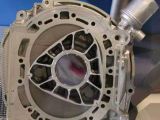The Wankel rotary engine is another type of internal combustion engine that features a very clever rearrangement of the four elements of the Otto cycle. It was invented by the German engineer Felix Wankel in the 1950s.
In the piston engine, the cylinder performs all four steps: intake, compression, combustion and exhaust. In the Wankel engine, there is a triangular rotor incorporating a central ring gear that is driven around a fixed pinion within an oblong chamber, so the same four jobs happen in their own part of the "cylinder" housing.
The four strokes of the Otto cycle take place in the space between a rotor, which is roughly triangular, and the inside of a housing. The housing of the engine has an epitrochoid shape, and the rotor has three sides, much like the intersection area between three circles having the same radius and with the centers forming an equilateral triangle.
Through the center of the rotor passes a central drive shaft, and when the rotor rotates around the crank on the shaft, in also describes an orbit around the shaft. The corners of the rotor are constructed so that they always touch the interior of the housing in the same time, thus dividing it into three moving combustion chambers.
On each side of the housing there are fixed gears with ring gears attached to it to ensure the proper orientation as the rotor moves. The motions of the rotor are much like Earth's rotation and revolution movements, so each side of the rotor gets closer and farther from the wall of the housing, compressing and expanding the combustion chamber similarly to the strokes of a piston in a cylinder engine.
Unlike a piston engine, that makes only one combustion stroke for every cylinder every two rotations, the combustion chambers in the rotary engine generates one combustion stroke per each driveshaft rotation, that is one power stroke per rotor orbital revolution and three power strokes per rotor rotation.
The fuel and air mixture is drawn in the intake port during the first phase of the rotation, the mixture is compressed during the second, then it burns, driving the rotor around and in the last phase the exhaust is expelled.
The Wankel engine promised higher power output with fewer moving parts than the Otto cycle engine, which it can actually deliver, however technical difficulties have apparently interfered with the widespread adoption.
Although engineers have been experimenting with rotary engines since 1967, with the Cosmo Sport car, or a prototype Wankel-diesel motorbike named "Grizzly" and even built trucks and buses, these experimental cars were never mass produced, until the Asian car manufacturer Mazda developed the RENESIS engine, which is the first (and only) mass produced Wankel engine, featured on models like Mazda RX-8.
Awarded the International Engine of the Year 2003 distinction, this naturally aspirated two-rotor engine produces about 250 horsepower, proving the capabilities of a good Wankel engine, but in spite of this achievement, most car manufacturers in the world are reluctant to equip their models with this alternative engine type.

 14 DAY TRIAL //
14 DAY TRIAL // 
